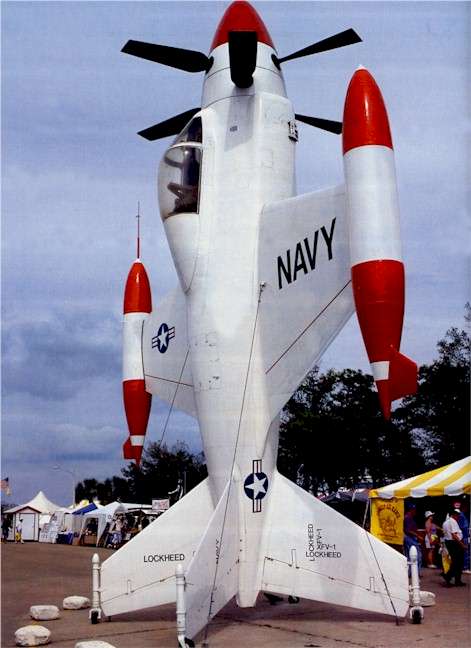Fishy: Salmon and Hammerheads
Lockheed XFV-1 SalmonDeath is a small price to pay for looking shit hot. - Aviation Quotes
Tail-sitting fighter from the US Naval Aviation Museum by Austin J Brown The prospect of a vertical take-off fighter able to operate from a small platform instead of a huge carrier deck had appeal to the US Navy and in 1950 it held a design competition to encourage proposals resulting in Lockheed receiving a contract to build two prototypes of the XFV-1 Salmon (sometimes called Vertical Riser). As with the Focke-Wulf design, this was a tail-sitter, using castor wheels on legs attached to the trailing-edge of the cruciform wings and/or tail fins as undercarriage units. It was powered by a 5,850 equivalent shaft hp Allison YT40 turboprop engine driving Curtiss-Wright Turboelectric co-axial contra-rotating propellers; the turboprop was itself a very new form of engine still in its infancy. Each pilot sat on a "gimbal" seat able to tilt according to the flight mode and gun or rocket armament was carried in wingtip pods. Following a large number of tethered flights using a special test rig constructed in a naval airship hangar at Moffett Field, the flying commenced. The Lockheed Salmon flew in March 1954 but was only ever flown horizontally using a special undercarriage rig and only one prototype was completed before the Navy terminated development. Source: The World's Strangest Aircraft: A Collection of Weird and Wonderful Flying Machines by Michael Taylor
Just noticed your article about the XFV-1. My son is the great grandson of the Lockheed test pilot who's name is on this plane, Herman "Fish" Salmon. Feel free to use the photo if you would like. It is a scan of an original Lockheed file photo. Craig J Rogers
Craig With gratitude. He looks like Clark Gable...
Scaled Composites Predator 480A free ride and free food are two of the three things no pilot ever turns down. - attributed to Dick Rutan I flew combat in Vietnam. I got shot at, I shot back, I got shot down. - Dick Rutan, regarding engine failure over the Pacific
Proof-of-concept agricultural aircraft One of the world's most prolific and respected designers is Elbert "Burt" Rutan. Among the ranks of enthusiast constructors who build their own aircraft for private use, Rutan's two-seat "homebuilts" are legend. He also designed the Voyager trimaran monoplane in which his brother Richard and Jeana Yeager made history during 14-23 December 1986 by successfully completing the first-ever non-stop and unrefuelled aeroplane flight around the world, in so doing establishing an absolute distance record of 24,986.664 miles (40,212.139 km). To a NASA requirement, Burt Rutan was responsible for designing the pivoting-wing AD-1 for oblique-wing research and, having set up Scaled Composites Incorporated, designed several very unusual aircraft with production possibilities. These include the composites-constructed Rutan 151 ARES agile-response effective-support military aircraft with rear-mounted wings, swept-forward canards and a fuselage with an offset 2,950-pound (1,338-kg) thrust Pratt and Whitney JT15D-1 turbofan, intended as an inexpensive battlefield attack aircraft. His Predator 480 was built as an agricultural aircraft and first flew in 1984. Work at Scaled on unusual aircraft continues. Source: The World's Strangest Aircraft: A Collection of Weird and Wonderful Flying Machines by Michael Taylor
To view other articles related to flying including history, unusual flying machines, hot air balloons, skydiving, gliding, problems,
airports, turbulence, pilots, crashes, the Paris Air Show, the future, blimps, space travel, solar sails and more, clicking the "Up" button
below takes you to the Table of Contents for this section on Flight. |
 Animals
Animals Animation
Animation Art of Playing Cards
Art of Playing Cards Drugs
Drugs Education
Education Environment
Environment Flying
Flying History
History Humour
Humour Immigration
Immigration Info/Tech
Info/Tech Intellectual/Entertaining
Intellectual/Entertaining Lifestyles
Lifestyles Men
Men Money/Politics/Law
Money/Politics/Law New Jersey
New Jersey Odds and Oddities
Odds and Oddities Older & Under
Older & Under Photography
Photography Prisons
Prisons Relationships
Relationships Science
Science Social/Cultural
Social/Cultural Terrorism
Terrorism Wellington
Wellington Working
Working Zero Return Investment
Zero Return Investment

